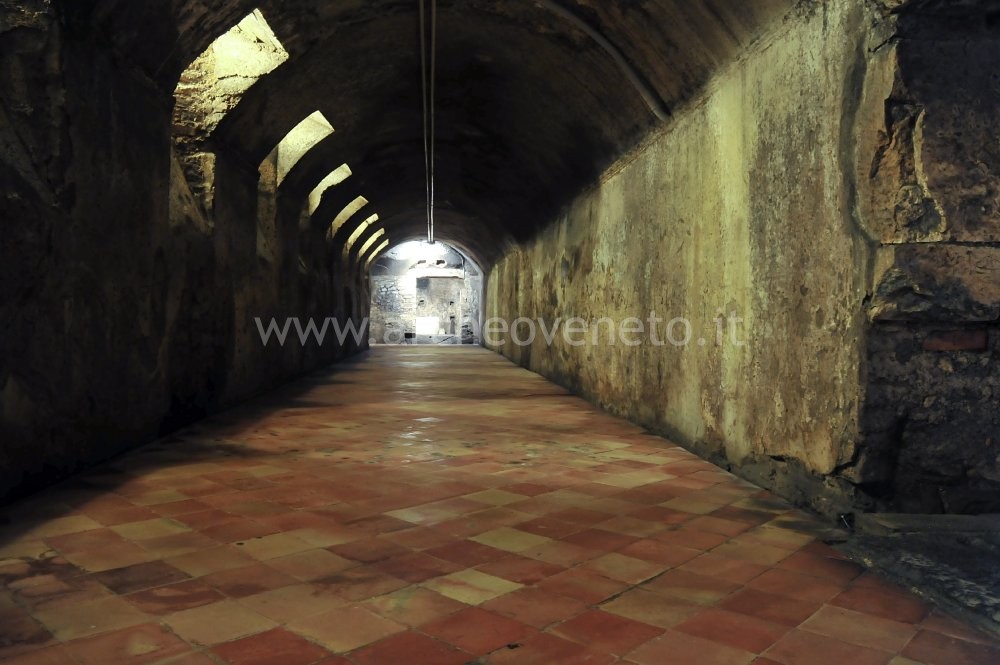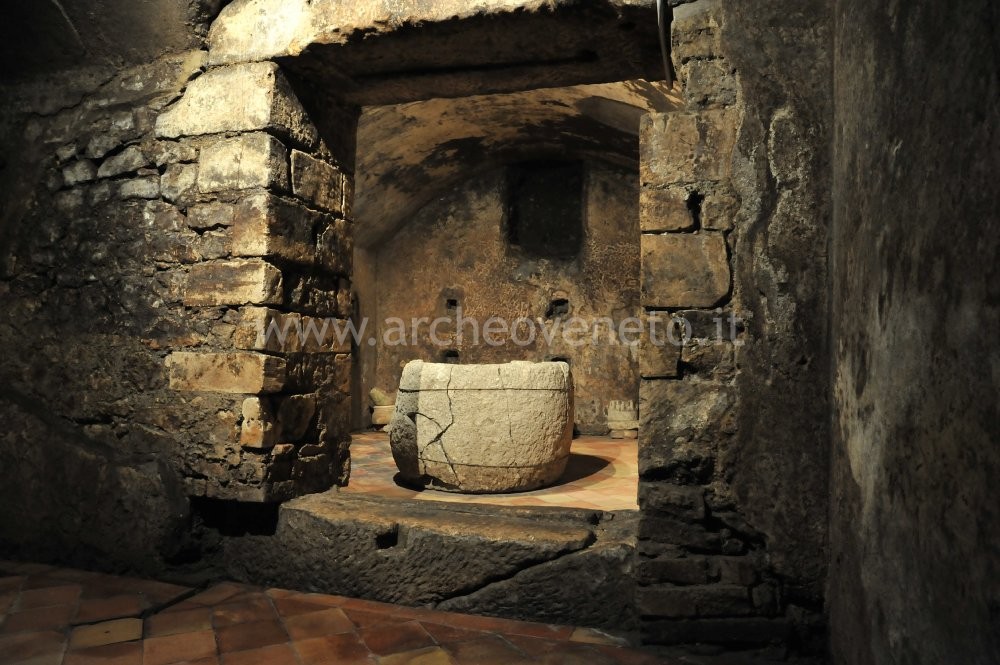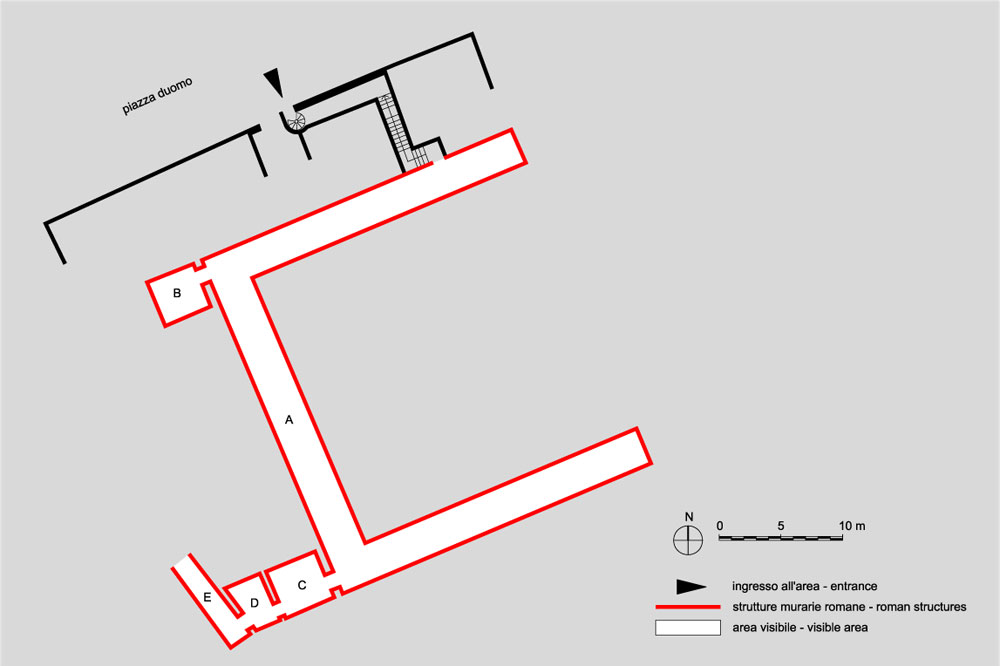|
|
File
Roman “cryptoporticus” in "Piazza Duomo" – Vicenza
|
| Piazza Duomo 6 – 36100 Vicenza (VI)
|
  |
|
Summary

The archaeological area conserves the remains of a Roman “cryptoporticus” dating back to the I century A.D. The “cryptoporticus”, a covered passageway, pertained to a rich urban house in Vicenza and all over northern Italy it is the only remaining example of this type of underground space.
History of research
The “cryptoporticus” was discovered and excavated in 1954 by the General Direction for Archaeological Heritage in the Veneto region.
Urban and geographical context
Vicenza is located in the west-central plains of Veneto, at an average altitude of 40 metres above sea level. The city is surrounded by the Berici hills on the south and by the south-eastern margins of the Lessinian mountains of the west/northwest. This archaeological area is located in the heart of the modern city and it used to be in the south-western compound of the Roman settlement.
Chronology
I A.D |
 {slide=Roman “cryptoporticus” in "Piazza Duomo" {slide=Roman “cryptoporticus” in "Piazza Duomo"
}
 The “cryptoporticus” in the square “Piazza Duomo” in Vicenza was the covered and underground passageway of a domus in the south-western part of the “municipium” of Vicenza and represents one of the few remaining examples of this type of underground rooms all over northern Italy. The “cryptoporticus” in the square “Piazza Duomo” in Vicenza was the covered and underground passageway of a domus in the south-western part of the “municipium” of Vicenza and represents one of the few remaining examples of this type of underground rooms all over northern Italy.
The domus to which this space belonged must have been located in the area which is currently occupied by the palace “palazzo Roma” and by the parsonage and must have extended up to part of the garden of the Bishopry. The southwest-northeast orientation of the domus coincides with that of the “decumanus maximus” and confirms that it fit perfectly in the square grid Roman city plan. If, as it seems, the grid was made of blocks of 80 metres per side, then this domus took almost half of one of them.
The cryptoportico was part of the underground space of the domus that supported the porch around the garden (peristyle). It’s a room that was built by using the natural height differences of the ground and which could be accessed through a two-flighted stair with a rather narrow entrance. The construction of the “cryptoporticus” dates back to I century A.D. but its use lasts for the whole Imperial time. The “cryptoporticus” is U-shaped (A) and measures 29,5 metres in its central branch and 27,35 metres in its lateral branches. The two squared rooms B and C enlarge the “cryptoporticus” and they are also underground parts of the house. A further slanting gallery (E) opens in room C through a trapezoidal room, but it has only partially been explored. The three branches of the “cryptoporticus” are about 3 metres large and 2,85 metres high and they are covered with barrel vaults. The light and air come in through 27 little splayed windows opening on the garden. The walls were covered with “marmorino” plaster, while the floor was renovated three times: the first time it was made of small hexagonal terracotta cubes, the second time it was made in mosaic, the third time it was of rectangular terracotta slabs. The three corridors were fresh in summer and protected during winter and for this reason they might have been extra living spaces of the house. The other rooms had rather service function: one of them was most likely a storeroom.{/slide}
|

Admission: Negli orari di apertura
Solo su prenotazione
Visitability: Interno
Ticket: No
 School access School access
Upon reservation
Opening Days
| Tipology |
When |
Specs |
| Summer |
Second Sunday of the month |
10-12 |
| Winter |
Second Sunday of the month |
10-12 |
Out of the timetable, the site is open with reservations. For information and reservations please call the C.T.G. Association – Gruppo Animatori Culturali (tel. 0444 226626; the office is open on Monday and on Wednesday 10-12).
Recommended tour time (minutes): 20
 Brochure Brochure
 Information boards Information boards
 Multilingual ads: Inglese Multilingual ads: Inglese
Brochure
 Guided Tours Guided Tours
Guided tours by the group "Gruppo Animatori Culturali" (tel. 0444 226626; reservations: Monday and Wednesday 10-12)
 Educational activities Educational activities
Teaching activities by the group "Gruppo Animatori Culturali" (tel. 0444 226626; reservations: Monday and Wednesday 10-12)
 Library and documentation centre Library and documentation centre
| Tosi G. 1975, Osservazioni sul criptoportico di Vicenza, in Venetia, Studi miscellanei di archeologia delle Venezie, III, Padova, pp. 143-156. |
| Marchini G.P. 1979, Vicenza romana: storia, topografia, monumenti, Verona, pp. 145-148. |
| Mangani E., Rebecchi F., Strazzulla M.J. 1981, Emilia, Venezie (Guide Archeologiche Laterza), Bari, pp. 152. |
| Rigoni M. 1987, La città romana: aspetti archeologici, in Storia di Vicenza, I, a cura di Broglio A., Cracco Ruggini L., Vicenza, pp. 176-179. |
| Rigoni M. 1987, Vicenza, in Il Veneto nell’età romana, II, a cura di Cavalieri Manasse G., Verona, pp. 125-128. |
| Rigoni M. 1998, Vicenza, in Tesori della Postumia. Archeologia e storia intorno a una grande strada romana alle radici dell’Europa, Catalogo della mostra (Cremona 4-4/26-7 1998), Milano, pp. 460-468. |
| Basso P., Bonetto J., Ghedini F. 2001, L’uso del sottosuolo nell’edilizia privata della Cisalpina romana, in Abitare in Cisalpina. L’edilizia privata nelle città e nel territorio in età romana, Antichità Altoadriatiche, XLIX, a cura di Verzàr-Bass M., pp. 164-170. |
| I luoghi della cultura 2006, Roma, pp. 386. |
| Bonetto J. 2009, Veneto (Archeologia delle Regioni d’Italia), Roma, pp. 464-465. |
|

